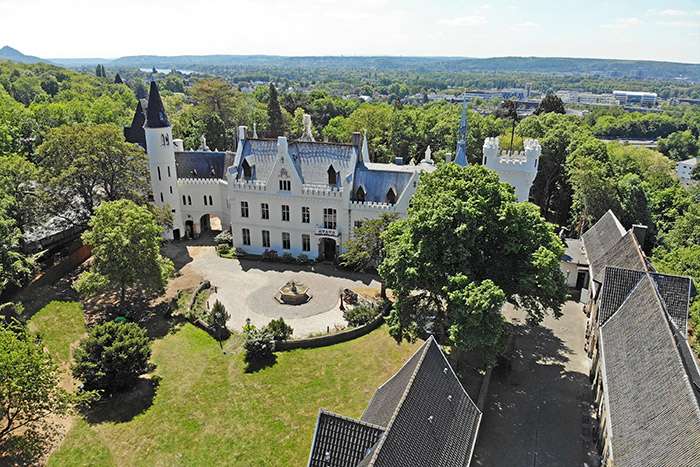
by Marisa De Luca | Mar, 2025 | architecture, EN, points of interest, Rhine region
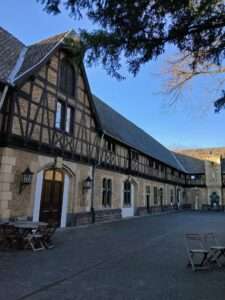 From the terrace of the castle, you can see as far as Cologne Cathedral and, of course, the whole of Bonn. The view, under a bright blue sky, is truly magical. Fortunately in the 1970s a citizens’ initiative was able to save the castle from demolition with a view to construct a motorway junction.
From the terrace of the castle, you can see as far as Cologne Cathedral and, of course, the whole of Bonn. The view, under a bright blue sky, is truly magical. Fortunately in the 1970s a citizens’ initiative was able to save the castle from demolition with a view to construct a motorway junction.
The castle has had a chequered history since it was built as the headquarters of the Teutonic Order in the 13th century in connection with the Crusades. Until secularisation in 1803, it was the economic base of the Teutonic Order and then the seat of several noble families. The remarkable architecture that can be seen today was created in a predominantly neo-Gothic style after a major fire broke out during reconstruction in 1842.
Among the numerous owners, the first youthful resident, Baroness von Francq (stepdaughter of the then owner, Prince Joseph zu Salm-Reifferscheidt-Dyck), deserves special mention. She lived in the castle from 1861 to 1881 and left her mark on the castle, which had since been spruced up with the addition of an English-style extension – at that time the rooms for the ladies – and the expansion of the extensive Ennert Park, including the planting of exotic trees. She also had some of the furnishings installed, which were unusually modern for the time, such as a powder room on the upper floor.
Another owner, Albert Moritz Freiherr von Oppenheim, also left his mark. As a banker and art collector, he was responsible for the interior design of the castle, which is particularly evident in the stairwell and in today’s restaurant. This heritage – wall panelling and historicist-style ceiling mouldings – was gradually restored by the new owners after the building was used by various institutions after the Second World War. The result is an extraordinary hotel and restaurant, and further rooms on the upper floor are being restored while business continues. Today, people are proud of the fact that Tina Turner liked to stay in a suite in the white tower, away from the hustle and bustle of Cologne, and that other celebrities, sheikhs with their families or guests from the worlds of business and politics now also stay here.
Since 2017, a Cologne restaurateur and an investment company have been running the extraordinary restaurant, hotel and the coach house for events. It is even possible to have a civil wedding here at the Schlosshotel Kommende. It’s definitely worth a visit!
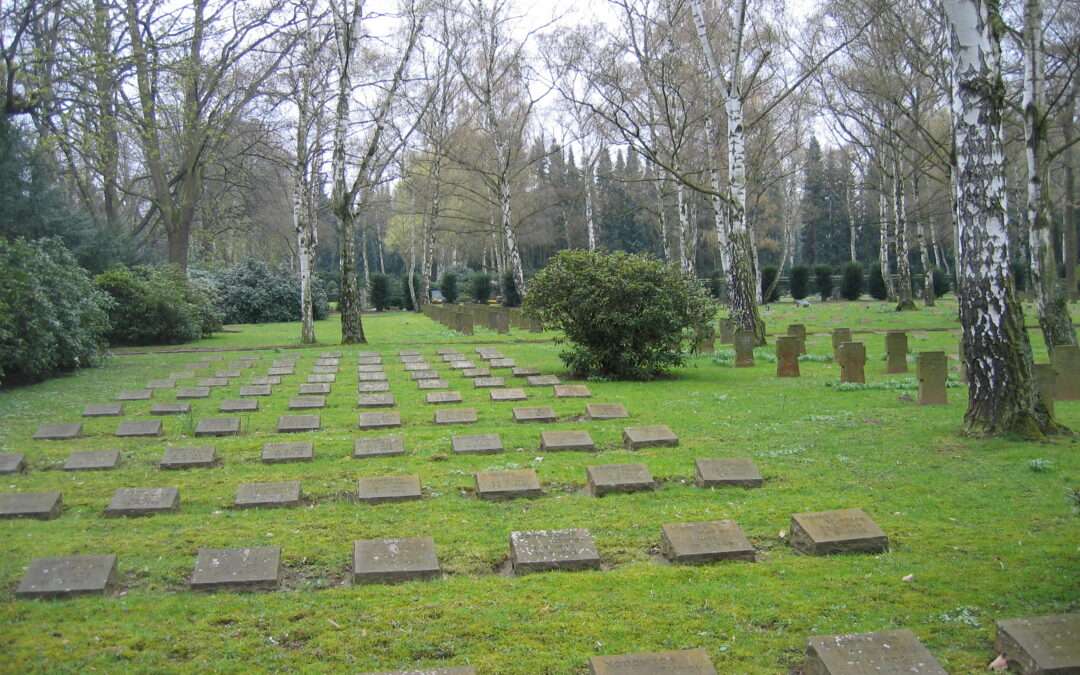
by Gert Fischer | Mar, 2025 | EN, points of interest, tradition
With the Old Cemetery in the city centre, the Bad Godesberg Castle Cemetery and the Poppelsdorf Cemetery, Bonn has three outstanding burial sites due to their significance, ambience or location. If you add to this the village churchyards in some districts that are still preserved and date back even further, Bonn’s cemetery landscape is almost worth a trip. This historical heritage overshadows the more modern facilities.
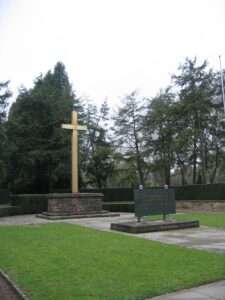
Photo: A. Savin
Thus, Bonn’s largest cemetery by far, the Nordfriedhof on Kölnstraße in today’s Auerberg district, is perhaps the Cinderella of cemeteries. Opened in 1884 as the official successor to the Old Cemetery, which could no longer be expanded, the Nordfriedhof got off to a bad start mainly due to its location. More than three kilometres from the centre of Bonn, it was on the far northern outskirts of the city. It only received a rail connection in 1906, when the Rheinuferbahn (Rhine bank railway) started operating. In the first decades of its existence, it was located in an open field. On the way there, you passed the smouldering rubbish heap where today’s Sportpark Nord is located, the Rheinische Provinzial-Irrenanstalt (today the LVR-Klinik Bonn), the Städtische Hilfshospital für Geisteskranke, Epileptiker und Trunksüchtige (a municipal hospital for the mentally ill, epileptics and alcoholics) and the orphanage and correctional home, which was located on the former site of the leprosarium (an isolation ward for infectious diseases). And contemporaries were certainly also aware that the cemetery area included the former place of execution with the gallows and the Schindanger, where animal carcasses that could no longer be used were disposed of. It is therefore not surprising that the so-called ‘better circles’ at the time sought burial sites elsewhere. After 1905, this was also officially possible. Those who lived ‘west of the railway’ could be buried in the cemetery of the recently incorporated Poppelsdorf. The inhabitants of the southern and western parts of the city made ample use of this opportunity. The Nordfriedhof thus became the cemetery for the city centre and the northern part of the city. Accordingly, the names of the families buried here that are significant in local history are linked to this part of the city. The graves of professors and wealthy individuals were buried mainly in the Poppelsdorf Cemetery, as were those of many of Bonn’s dignitaries.
Nevertheless, the North Cemetery gradually gained its place in the Bonn cemetery landscape. It changed for the better as a park, designed in an exemplary manner including a large chapel added in 1913. Its subsequent three expansions prove that it has become a popular cemetery. Even the reckless handling of some of its remnants could not prevent this. In the 1960s, for example, rows of gravestones were cleared when the main entrance was widened, and the neo-Romanesque gate was demolished. As a result, the list of ‘preserving-worthy’ grave monuments is short compared to the size of the cemetery.
The character of the Nordfriedhof as a cemetery of honour represents a special chapter. The beginnings of this development lie in the First World War. Today, not only the German victims of two world wars are buried here, but also numerous forced and foreign labourers as well as prisoners of war. Initially a place of local remembrance, the war cemetery and cemetery of honour became the central ‘Memorial of the Federal Republic of Germany for the Victims of War and the Victims of Tyranny’ in 1980 (today in Berlin at the Neue Wache). At that time, the bronze plate designed by Hans Schwippert – known as the architect who converted the Pedagogical Academy into the Bundeshaus and Palais Schaumburg into the Federal Chancellery – was transferred from the Hofgarten to the Nordfriedhof for this purpose. One of the more embarrassing chapters in Bonn’s history is that in 2017 it was stolen and replaced by a copy in sandstone.
As a relatively modern cemetery, the Nordfriedhof was not consecrated by a Catholic priest and was not bound to historical structures. Therefore, it reflects the developments that have shaped the funeral industry in the recent past better than many older cemeteries and those that are subject to preservation orders that restrict them to an earlier state. For example, a Yazidi cemetery is integrated into the Nordfriedhof. There are graves where the Greek Orthodox or Russian Orthodox rites were observed, as well as an area for children who died in the womb or at birth. And since 1990, it has had an Islamic burial ground.
A walk through the Nordfriedhof Cemetery is therefore not so interesting if you are interested in art, historically significant graves and famous names. Rather, it is a generously laid out park that reflects the social structure of Bonn city centre and the north of Bonn. Nevertheless, exciting discoveries are not out of the question. For example, there are three graves of members of the Sikh religious community who came to Bonn with the British occupation troops after the First World War. Or the grave of the singer and entertainer Fereydun Farrochsad, who was murdered in Bonn in 1992 in the name of the Islamic revolution in Iran.
Furthermore, the Nordfriedhof is of ecological interest. It has remarkable trees and, due to its size, a wide variety of animal and plant life. With the support of the Rotary Club, the city of Bonn is using it as an experimental area for ‘future trees’ – as a ‘climate grove’.
It is to be hoped that the restoration work on the cemetery chapel, which has been going on for two years now, will finally be completed. Until then, funeral services are held in an unworthy plastic tent. The North Cemetery is still worth a visit!
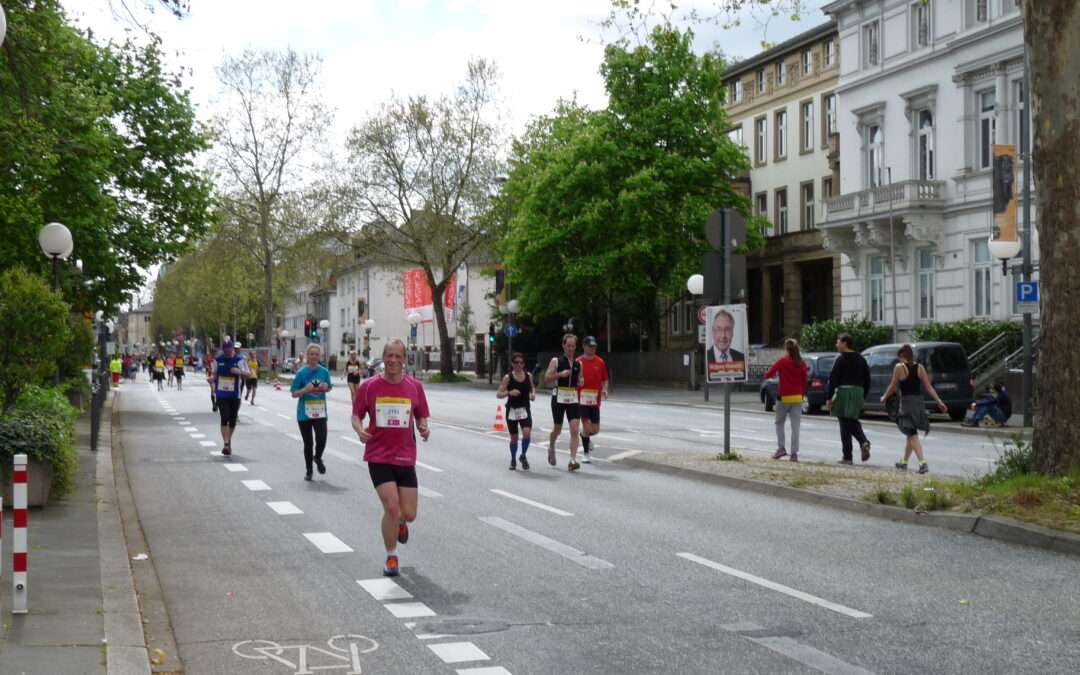
by Stefan Heinze | Mar, 2025 | EN, Sports, tradition
I moved to Bonn in 1986. Shortly after that, I met Helmut Thillmann at a seminar. He organised the early-morning sports and showed us how relaxed he could run fast and long when we went jogging.
What he didn’t tell us is that on 29 January 1986 he, together with Karl Lennartz, Axel Bosse, Hansjürgen Melzer, Thomas Greiser and Wolf-Dirk von Berchem, founded the ‘Marathon Bonn e.V. (source: GA from 5.4.2016). A significant amount of time was needed for the planning and organisation. Three years later – marking Bonn’s 2000th anniversary – the first marathon took place on 10 June 1989 in the former capital.
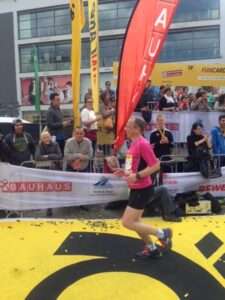 Closing streets for a marathon was new for Bonn. The administration provided arguments against, such as, ‘The runners should stop at red lights’ (Source: GA from 11.06.2024) Despite this, a date in summer was chosen because it is traditionally a marathon-poor time. In addition, in the 1980s, shops closed at 2 p.m. on Saturdays, and most employees had the day off.
Closing streets for a marathon was new for Bonn. The administration provided arguments against, such as, ‘The runners should stop at red lights’ (Source: GA from 11.06.2024) Despite this, a date in summer was chosen because it is traditionally a marathon-poor time. In addition, in the 1980s, shops closed at 2 p.m. on Saturdays, and most employees had the day off.
At the first marathon in Bonn, 2,443 runners finished, including 156 women. The time limit was five hours. It is hard to imagine today that 375 men and 10 women broke the magical three-hour mark. 1969 athletes completed the course in a time of under four hours. (Source: ibid.), On 5 June 1993, after the fifth marathon, the sponsor withdrew. The quote from back then: ‘For that money, we could get a season’s advertising deal with 1. FC Köln.’ (Source: ibid.)
It was not until 2001 that the marathon was permanently reinstated. Since 2005, the half marathon has also been offered. In 2005, I started running as a former judoka. The beginning was difficult – and it took until the summer of 2006 for me to complete the so-called small bridge 10 km lap (Kennedy and South Bridge) for the first time. That’s when a raffle was held by my employer: up to 25 starting places including preparation training. What could possibly go wrong? At worst, I win!
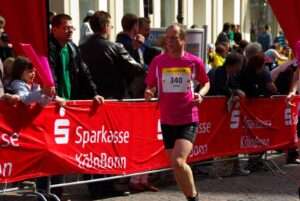 What I didn’t realise was that everyone who entered would win! Experience shows that only a few people stick to their training schedule from the beginning until the race in April. In addition to the twice-weekly training sessions starting at the company gate, there are Sunday runs starting at Kloster Heisterbach. And Helmut Tillmann is also one of the trainers!
What I didn’t realise was that everyone who entered would win! Experience shows that only a few people stick to their training schedule from the beginning until the race in April. In addition to the twice-weekly training sessions starting at the company gate, there are Sunday runs starting at Kloster Heisterbach. And Helmut Tillmann is also one of the trainers!
In Janaury 2007 the storm Kyril hit during the running training phase. Hence the 28 km Sunday run took a lot longer than usual due to the many detours needed. Comment from the trainer: I’ll register everyone who is still registered for the half marathon for the marathon.
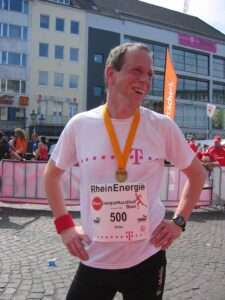 And so, without ever having participated in a half marathon, I ran my first marathon on 22 April 2007. For the last time, the route also went through Godesberg, Rüngsdorf, Friesdorf, Poppelsdorf, past the Sportpark Nord to Josefshöhe and then to the market square.
And so, without ever having participated in a half marathon, I ran my first marathon on 22 April 2007. For the last time, the route also went through Godesberg, Rüngsdorf, Friesdorf, Poppelsdorf, past the Sportpark Nord to Josefshöhe and then to the market square.
Today, the marathon course is twice the half marathon distance: starting near the opera house, over the Kennedybrücke and then south to the Südbrücke and parallel to the Rhine back towards the Kennedybrücke. A samba band plays at the bridge ramp to support the runners and pick up the pace. A large loop around the Beethovenhalle and then along the Rhine promenade (where the Bonn Rowing Club provides the runners with Kölsch beer) to the Rheinaue and on to the Caesar Research Institute.
In the past, the marathon runners continued straight ahead here, but today all runners turn here and run along Konrad-Adenauer-Allee to the Hofgarten. This route is often almost without spectators. From the Hofgarten, the route continues via Münsterplatz and Bottlerplatz to the market square, where the finish is.
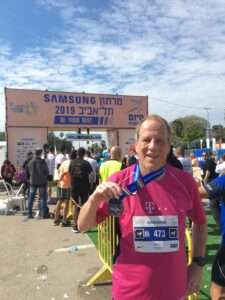 For the last two kilometres, the spectators carry you to the finish (or into the second round). There is a great atmosphere on both sides of the running track.
For the last two kilometres, the spectators carry you to the finish (or into the second round). There is a great atmosphere on both sides of the running track.
While the number of registrations for the marathon remains stable, the number of registrations for the half marathon continues to rise. In 2025, 10,000 runners will start in the half marathon.
After running the marathon in Bonn several times, as well as in Istanbul, Florence, Nice to Cannes and on Lake Garda, I completed my 15th marathon in Tel Aviv in 2019.
Due to Corona, there was a longer break from running – and without a goal, I also drastically reduced my training. Now I am registered again for the half marathon in Bonn in 2025.
If you want more detailed information about the running track and the individual competitions (also for inline skaters, handbikers or relays), follow the link to the organiser: Deutsche Post Marathon Bonn

 From the terrace of the castle, you can see as far as Cologne Cathedral and, of course, the whole of Bonn. The view, under a bright blue sky, is truly magical. Fortunately in the 1970s a citizens’ initiative was able to save the castle from demolition with a view to construct a motorway junction.
From the terrace of the castle, you can see as far as Cologne Cathedral and, of course, the whole of Bonn. The view, under a bright blue sky, is truly magical. Fortunately in the 1970s a citizens’ initiative was able to save the castle from demolition with a view to construct a motorway junction.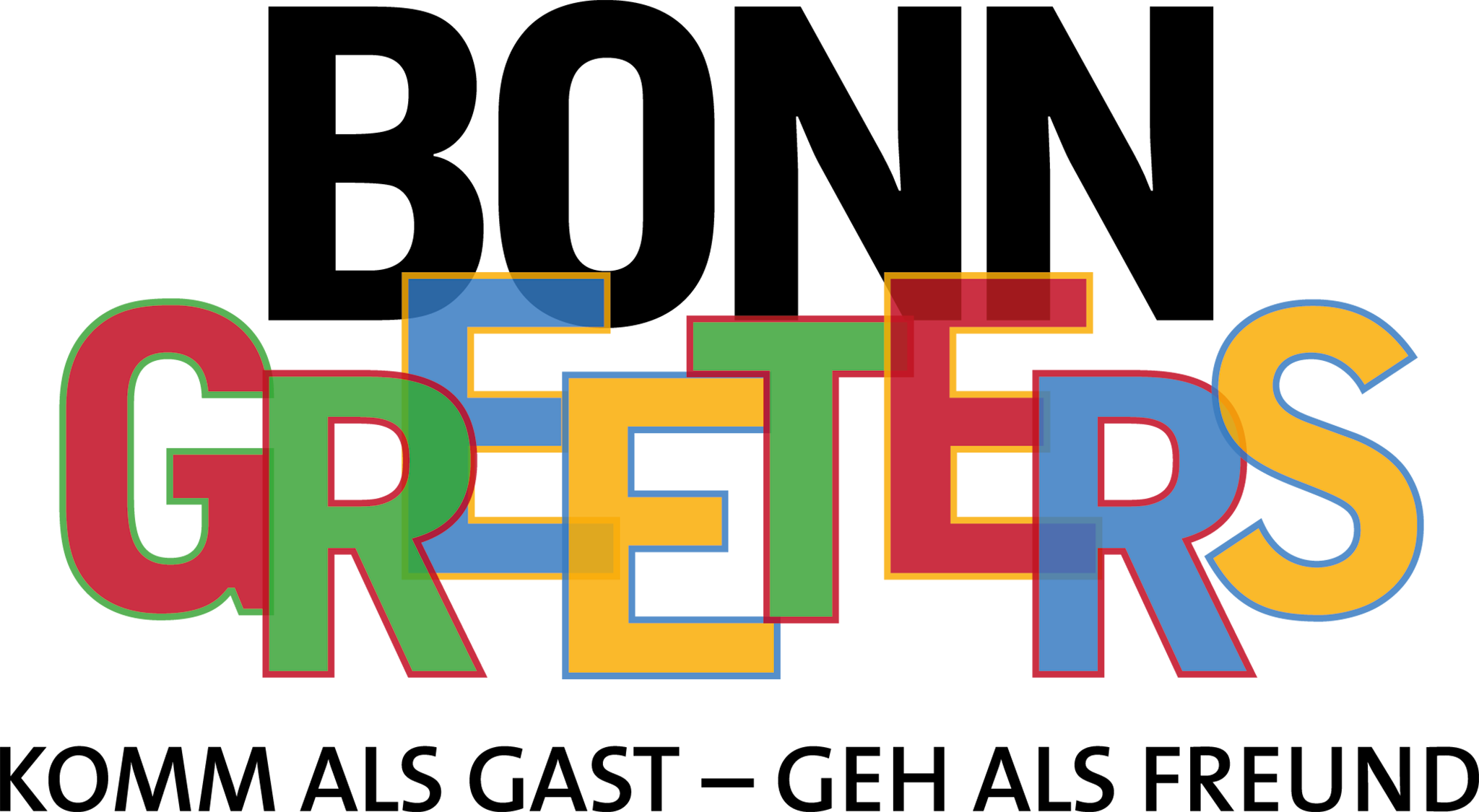
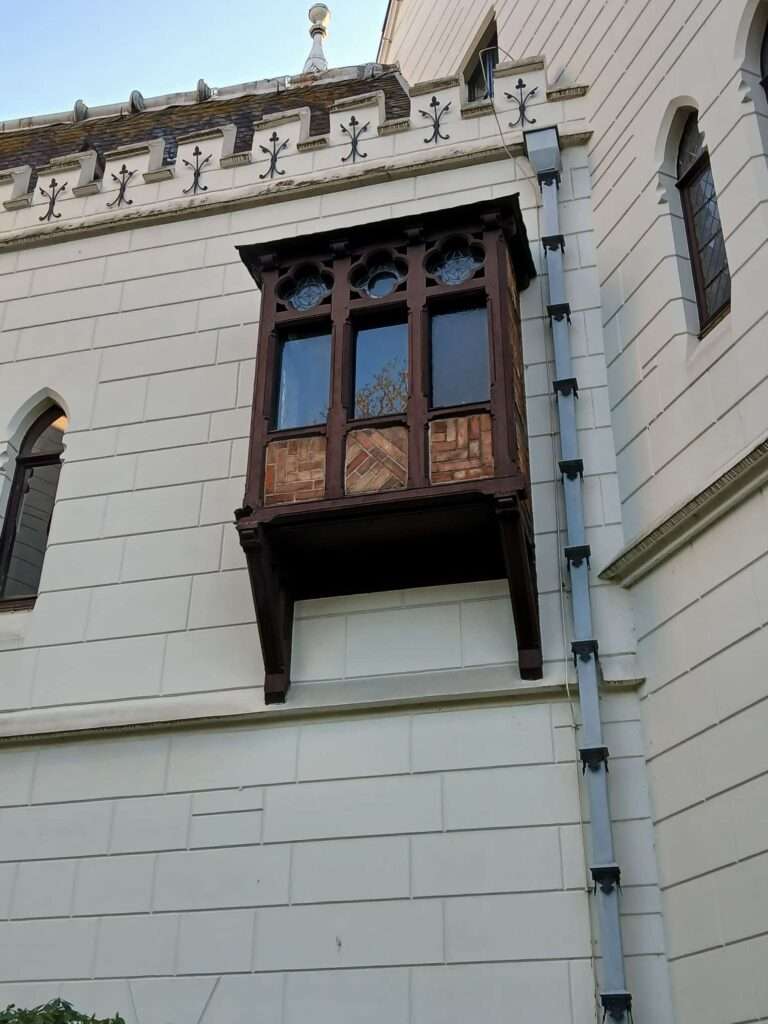
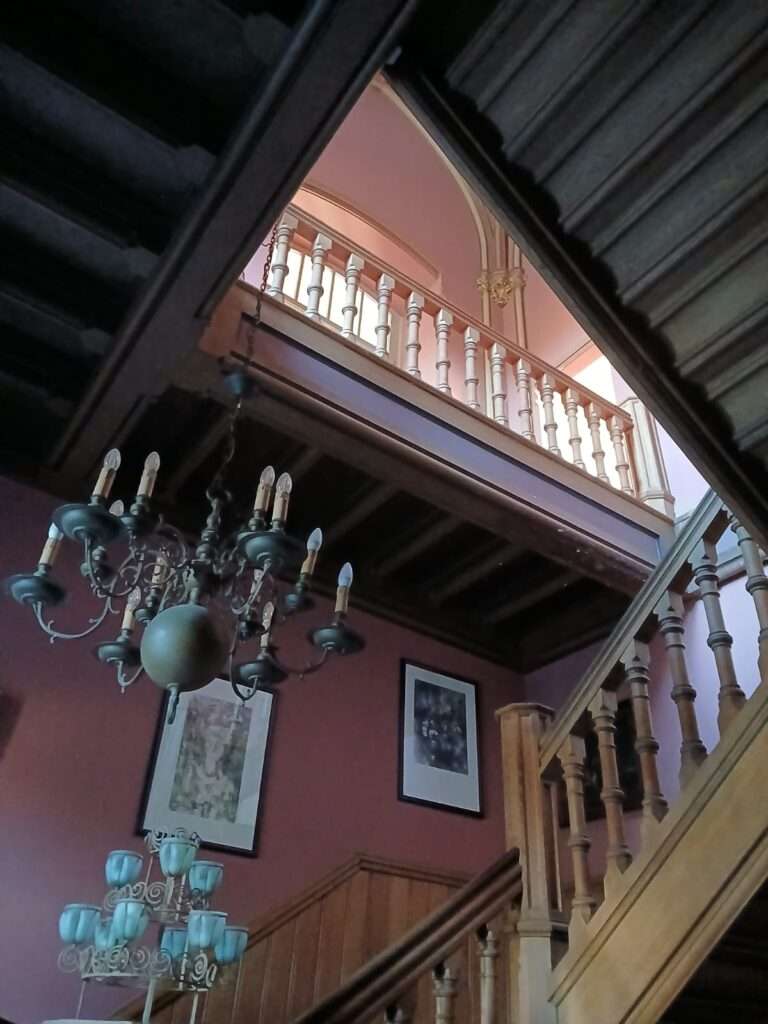

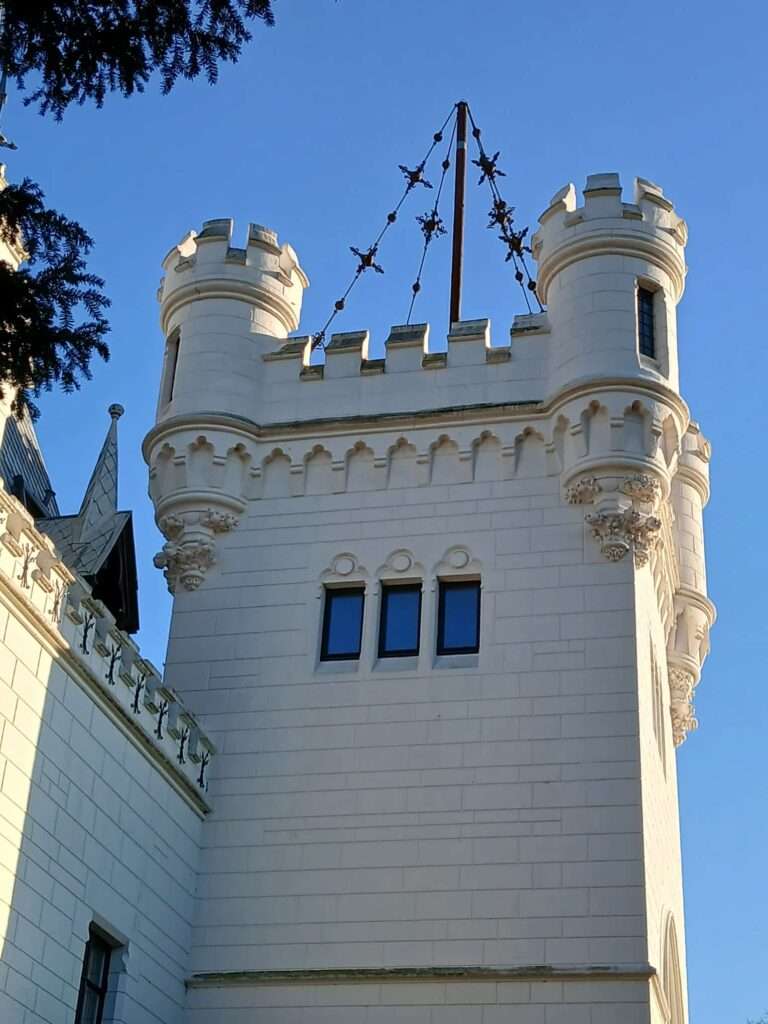



 Closing streets for a marathon was new for Bonn. The administration provided arguments against, such as, ‘The runners should stop at red lights’ (Source: GA from 11.06.2024) Despite this, a date in summer was chosen because it is traditionally a marathon-poor time. In addition, in the 1980s, shops closed at 2 p.m. on Saturdays, and most employees had the day off.
Closing streets for a marathon was new for Bonn. The administration provided arguments against, such as, ‘The runners should stop at red lights’ (Source: GA from 11.06.2024) Despite this, a date in summer was chosen because it is traditionally a marathon-poor time. In addition, in the 1980s, shops closed at 2 p.m. on Saturdays, and most employees had the day off. What I didn’t realise was that everyone who entered would win! Experience shows that only a few people stick to their training schedule from the beginning until the race in April. In addition to the twice-weekly training sessions starting at the company gate, there are Sunday runs starting at Kloster Heisterbach. And Helmut Tillmann is also one of the trainers!
What I didn’t realise was that everyone who entered would win! Experience shows that only a few people stick to their training schedule from the beginning until the race in April. In addition to the twice-weekly training sessions starting at the company gate, there are Sunday runs starting at Kloster Heisterbach. And Helmut Tillmann is also one of the trainers! And so, without ever having participated in a half marathon, I ran my first marathon on 22 April 2007. For the last time, the route also went through Godesberg, Rüngsdorf, Friesdorf, Poppelsdorf, past the Sportpark Nord to Josefshöhe and then to the market square.
And so, without ever having participated in a half marathon, I ran my first marathon on 22 April 2007. For the last time, the route also went through Godesberg, Rüngsdorf, Friesdorf, Poppelsdorf, past the Sportpark Nord to Josefshöhe and then to the market square. For the last two kilometres, the spectators carry you to the finish (or into the second round). There is a great atmosphere on both sides of the running track.
For the last two kilometres, the spectators carry you to the finish (or into the second round). There is a great atmosphere on both sides of the running track.
Recent Comments